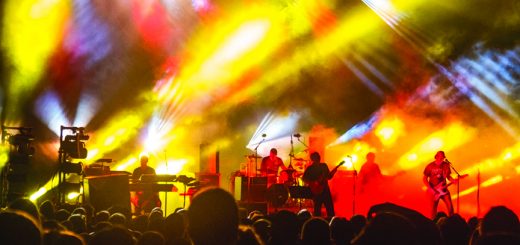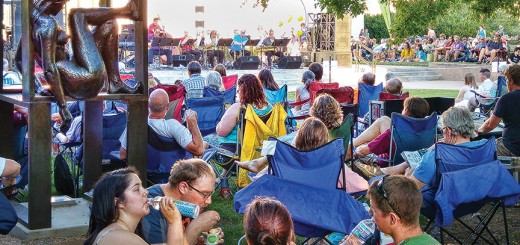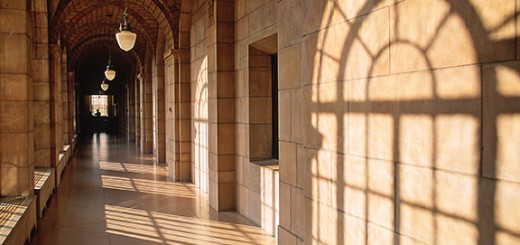Nebraska’s Capitol

by Cynthia S. Peterson
Nebraska’s state Capitol building is the nation’s first modern statehouse. But the building you see at 1445 K Street on the south edge of downtown is not the original. It’s actually the third one built in the same spot. (The first two territorial capitols (1855 and 1858) were built in Omaha. Moving the seat of government out of Omaha, the state’s largest city, southwest to the tiny hamlet of Lincoln was a controversial decision.
Fearing Omaha might ‘recapture’ the seat of government and return it to Omaha, there was a rush to finish the new Capitol in time for the legislature to convene in January 1869. The new building (Nebraska’s third Capitol) was ready in time but almost immediately began to crumble because of construction shortcuts and inferior stone.
The fourth Capitol was built bigger but not much better on the same site. Soon after completion in 1888, it started to decay. In 1919 the Legislature passed a bill to provide for the construction of a new Capitol, properly designed to withstand Nebraska’s climate.
With a budget of $10M, the fifth and current building was built in four phases and completed in 1932 after 10 years of pay-as-you-go construction. The Legislature had embraced the modern design by architect Bertram Goodhue—a significant departure from the neoclassical style epitomized by the U.S. Capitol building. Goodhue saw the building as a monument to Nebraska’s heritage. Sadly, Goodhue died before his masterpiece was completed.
Today, the Capitol houses the main executive and judicial offices of Nebraska, and is home to the only state unicameral legislature in the U.S. The interior is stunning, due in no small part to the extraordinary tile mosaics created by Hildreth Meiere.
The importance of art is one of the things that differentiates the Nebraska Capitol from capitols in many other states. Goodhue was inspired by the architecture of gothic churches that incorporated ornamentation to inspire emotion and teach stories from the Bible. Decoration in Nebraska’s Capitol was to be similar in spirit and focus on the stories of Nebraska. His consultant Hartley Alexander, Ph.D., established the themes of government, law, nature and society for artwork and inscriptions which would represent Nebraska.
Today, the themes are particularly apparent in the ceremonial chambers for the branches of government and in the building’s most public spaces. In many ways, the building and its art reads like a book about Nebraska.
Goodhue’s plans included recessed spaces on the walls for large murals on the second floor—three each in the rotunda and vestibule, and six in the foyer—to complement Meiere’s exquisite mosaics on the floor and ceiling. Eight more murals were planned for the octagonal Memorial Chamber at the top of the office tower.
While the building was completed in 1932, the Great Depression stalled the commissioning, creation and installation of the 20 planned murals. Between 1956 and 1990, a series of mural competitions on a nationwide scale finally fulfilled Goodhue’s and Alexander’s vision for art and storytelling. Artists including Jeanne Reynal, Reinhold Marxhausen and James Penney created Venetian glass or oil-on-canvas murals that now fill all 20 spaces. As one can imagine, artistic styles changed over the intervening years since the Great Depression, and did not necessarily match the vision from 1932. Instead, they complement the building’s stunning architecture and hold true to Alexander’s four themes.
My three particular favorites are in the Capitol’s great hall-
Jeanne Reynal’s mural, The Blizzard of 1888, is an abstract telling of the story of a ferocious blizzard that tore the roof off a sod schoolhouse in Nebraska and the young teacher who saved her students by leading them through the storm to a farmstead a half mile away.
The other two are abstracts by Reinhold Marxhausen. The Spirit of Nebraska was installed in January 1966. Much symbolism was incorporated into the piece, including a box of human remains (lower, middle of the mural). Marxhausen later explained, “Those bones are dedicated to all the deadheads in Nebraska, the lazy people, the people satisfied with the status quo, the people who are stubbornly determined not to succeed, all who resist change.”
His second mural, The Building of the Capitol was installed later that same year. It included a representation of the methods and technology used in the construction of the second Capitol building. This tenet from the Declaration of Independence is front and center in the piece, “All men are endowed by their creator with certain unalienable rights among these are life, liberty and the pursuit of happiness.”
The other glass mosaics in the great hall are: The Tree Planting by Reynal; The Coming of the Railroad by F. John Miller, and The U.S. Survey by Charles Clement,
Visit the Nebraska Capitol to discover your favorites, too. Both outside and inside, be sure to look up.
As you walk up to the building, take note of the names of Nebraska’s 93 counties engraved around the base and the stone carvings representing historic events in the evolution of democracy as a form of government. The tower is capped by The Sower—the 19.5-foot bronze finial designed by Lee Lawrie. The Sower is one of the few if not the only works of art at the Capitol that is free-standing.
Inside, Goodhue’s intentions to represent both indigenous people and Europeans who came to settle Nebraska are infused in the details of the public spaces. Your visit will be time well spent.
The building is usually open Monday-Friday, 8 a.m. to 5 p.m.; Saturdays and most holidays, 10 a.m. to 5 p.m., and Sundays, 1 to 5 p.m. Free guided tours are available. Call the tour office at 402-471-0448 or see capitol.nebraska.gov/visit/ for more information.














Recent Comments